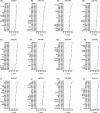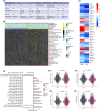Machine learning-derived identification of prognostic signature for improving prognosis and drug response in patients with ovarian cancer
- PMID: 37994489
- PMCID: PMC10805490
- DOI: 10.1111/jcmm.18021
Machine learning-derived identification of prognostic signature for improving prognosis and drug response in patients with ovarian cancer
Abstract
Clinical assessments relying on pathology classification demonstrate limited effectiveness in predicting clinical outcomes and providing optimal treatment for patients with ovarian cancer (OV). Consequently, there is an urgent requirement for an ideal biomarker to facilitate precision medicine. To address this issue, we selected 15 multicentre cohorts, comprising 12 OV cohorts and 3 immunotherapy cohorts. Initially, we identified a set of robust prognostic risk genes using data from the 12 OV cohorts. Subsequently, we employed a consensus cluster analysis to identify distinct clusters based on the expression profiles of the risk genes. Finally, a machine learning-derived prognostic signature (MLDPS) was developed based on differentially expressed genes and univariate Cox regression genes between the clusters by using 10 machine-learning algorithms (101 combinations). Patients with high MLDPS had unfavourable survival rates and have good prediction performance in all cohorts and in-house cohorts. The MLDPS exhibited robust and dramatically superior capability than 21 published signatures. Of note, low MLDIS have a positive prognostic impact on patients treated with anti-PD-1 immunotherapy by driving changes in the level of infiltration of immune cells. Additionally, patients suffering from OV with low MLDIS were more sensitive to immunotherapy. Meanwhile, patients with low MLDIS might benefit from chemotherapy, and 19 compounds that may be potential agents for patients with low MLDIS were identified. MLDIS presents an appealing instrument for the identification of patients at high/low risk. This could enhance the precision treatment, ultimately guiding the clinical management of OV.
Keywords: immunotherapy; machine learning; ovarian cancer; tumour microenvironment.
© 2023 The Authors. Journal of Cellular and Molecular Medicine published by Foundation for Cellular and Molecular Medicine and John Wiley & Sons Ltd.
Conflict of interest statement
The authors have no conflict of interest to declare.
Figures









Similar articles
-
Machine learning-derived identification of tumor-infiltrating immune cell-related signature for improving prognosis and immunotherapy responses in patients with skin cutaneous melanoma.Cancer Cell Int. 2023 Sep 26;23(1):214. doi: 10.1186/s12935-023-03048-9. Cancer Cell Int. 2023. PMID: 37752452 Free PMC article.
-
Machine learning-based integration develops an immune-related risk model for predicting prognosis of high-grade serous ovarian cancer and providing therapeutic strategies.Front Immunol. 2023 Apr 5;14:1164408. doi: 10.3389/fimmu.2023.1164408. eCollection 2023. Front Immunol. 2023. PMID: 37090728 Free PMC article.
-
Suppressive stroma-immune prognostic signature impedes immunotherapy in ovarian cancer and can be reversed by PDGFRB inhibitors.J Transl Med. 2023 Sep 1;21(1):586. doi: 10.1186/s12967-023-04422-x. J Transl Med. 2023. PMID: 37658364 Free PMC article.
-
Feasibility of machine learning-based modeling and prediction to assess osteosarcoma outcomes.Sci Rep. 2025 May 19;15(1):17386. doi: 10.1038/s41598-025-00179-z. Sci Rep. 2025. PMID: 40389469 Free PMC article.
-
Identification and validation of pyroptosis-related gene landscape in prognosis and immunotherapy of ovarian cancer.J Ovarian Res. 2023 Jan 27;16(1):27. doi: 10.1186/s13048-022-01065-2. J Ovarian Res. 2023. PMID: 36707884 Free PMC article.
Cited by
-
Comparing the Effectiveness of Artificial Intelligence Models in Predicting Ovarian Cancer Survival: A Systematic Review.Cancer Rep (Hoboken). 2025 Mar;8(3):e70138. doi: 10.1002/cnr2.70138. Cancer Rep (Hoboken). 2025. PMID: 40103563 Free PMC article.
-
Machine learning derived development and validation of extracellular matrix related signature for predicting prognosis in adolescents and young adults glioma.Sci Rep. 2025 Aug 7;15(1):28926. doi: 10.1038/s41598-025-13547-6. Sci Rep. 2025. PMID: 40774998 Free PMC article.
-
Machine and Deep Learning for the Diagnosis, Prognosis, and Treatment of Cervical Cancer: A Scoping Review.Diagnostics (Basel). 2025 Jun 17;15(12):1543. doi: 10.3390/diagnostics15121543. Diagnostics (Basel). 2025. PMID: 40564863 Free PMC article. Review.
-
Enhancing Personalized Chemotherapy for Ovarian Cancer: Integrating Gene Expression Data with Machine Learning.Asian Pac J Cancer Prev. 2025 Mar 1;26(3):959-967. doi: 10.31557/APJCP.2025.26.3.959. Asian Pac J Cancer Prev. 2025. PMID: 40156413 Free PMC article.
-
The complement C3a/C3aR pathway is associated with treatment resistance to gemcitabine-based neoadjuvant therapy in pancreatic cancer.Comput Struct Biotechnol J. 2024 Oct 5;23:3634-3650. doi: 10.1016/j.csbj.2024.09.032. eCollection 2024 Dec. Comput Struct Biotechnol J. 2024. PMID: 39469671 Free PMC article.
References
MeSH terms
LinkOut - more resources
Full Text Sources
Medical

